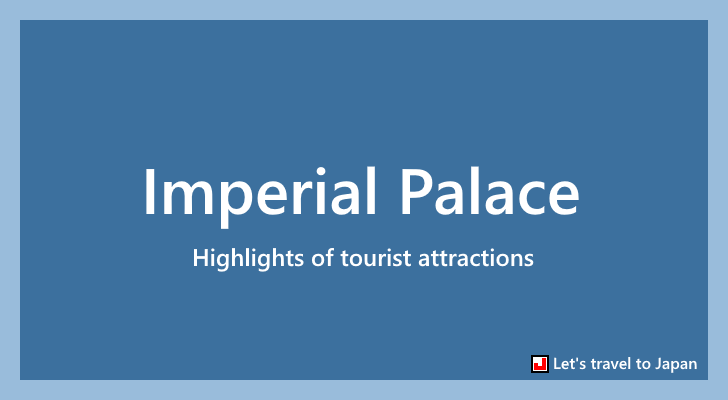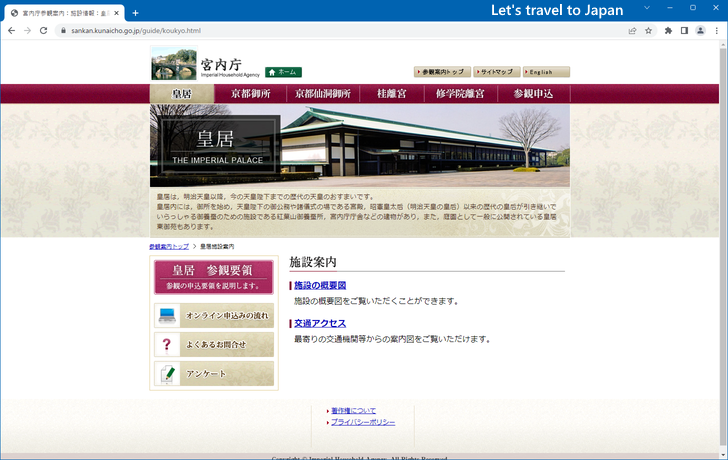Highlights and access methods of Imperial Palace (Tokyo Prefecture)
English | Japanese
The Imperial Palace is where the Emperor has resided since the Meiji era, and is located on the site of the former Edo Castle. It includes areas such as the private residence and palace which are not generally open to the public, as well as the East Gardens of the Imperial Palace, which are open to the public as a garden. Adjacent to these, there are also the Outer Gardens of the Imperial Palace and Kitanomaru Park. By participating in the general public tour of the Imperial Palace, you can also visit parts of the areas not usually open to the public.
In this article, we will explain the attractions of Imperial Palace in Tokyo Prefecture and how to access it for those who are traveling to Japan from overseas.

(Last modified: )
(Prefecture : Tokyo , Category : Buildings and Commercial Facilities)
Table of contents
Highlights of Imperial Palace
The Imperial Palace is located in Chiyoda Ward, Tokyo, and has been the residence of the Emperors since the reign of Emperor Meiji. Originally, part of the site where Edo Castle stood became the Imperial Palace, which includes structures like the Palace and the Imperial Household Agency building within its grounds. In addition, the East Gardens of the Imperial Palace are open to the public as a garden.
For areas of the Imperial Palace that are not generally open to the public, you can participate in the Imperial Palace General Visit to tour places like the Palace and the Imperial Household Agency building. It is held twice a day, in the morning and the afternoon, except on days when it is closed. You can either apply in advance or obtain a numbered ticket on a first-come, first-served basis on the day (capacity is limited).
The East Gardens of the Imperial Palace, which are now open to the public as a garden, were the sites of the Honmaru, Ninomaru, and Sannomaru of the old Edo Castle. Within the garden, there are places like the Tenshudai, which used to house the castle tower, and the Fujimi-yagura, the only turret still in existence. The area where the Ooku (the women's quarters) and other structures used to be is now a lawn plaza.
Adjacent to the Imperial Palace are the Outer Gardens of the Imperial Palace and Kitanomaru Park. The Outer Gardens of the Imperial Palace, which were where the Nishinomaru of Edo Castle used to be, are now open to the public as a park, and within its grounds, you can find things like the Nijubashi Bridge and a bronze statue of Kusunoki Masashige. Kitanomaru Park, which used to be where the Kitanomaru of Edo Castle was, is also open to the public as a park, and houses structures such as the Nippon Budokan and the Science Museum.
The grounds of the Imperial Palace are vast. You can take your time to stroll around, or you can participate in the Imperial Palace General Visit to tour the key sites efficiently. In addition, Kitanomaru Park is adjacent to the Chidorigafuchi, famous for its cherry blossoms. It can be enjoyable to stroll around in sync with the cherry blossom viewing season.
Address and access method of Imperial Palace
The address of the Imperial Palace is "1-1 Chiyoda, Chiyoda-ku, Tokyo". The Imperial Palace has several gates. JR Tokyo Station is the closest station to the Otemon Gate of the Imperial Palace. It's about a 15 minute walk from the station. Or Otemachi subway station. It's about a 5 minute walk from the station.
Attractions near Imperial Palace
Several notable attractions are located near Imperial Palace:
Tokyo Station
This is not just a transport hub but also a historic site and shopping haven. The building's red-brick facade is an architectural marvel, contrasting the city's modern skyscrapers. Inside, you'll find a range of dining and shopping options, as well as the Tokyo Station Gallery which holds regular art exhibitions.
Hibiya Park
One of Tokyo's most elegant parks, Hibiya Park is located close to the Palace. With its western-style gardens, picturesque ponds, and beautiful seasonal flower displays, the park offers a peaceful escape from the city bustle.
Yasukuni Shrine
This Shinto shrine commemorates Japan's war dead. Its precincts house the Yushukan Museum, which provides insights into Japan's military history. It is a short walk from the palace and its cherry blossoms in spring are particularly impressive.
National Museum of Modern Art
This museum boasts a vast collection of artworks spanning the Meiji Era to the present. It's a great place to appreciate Japanese and international modern and contemporary art. It is easily accessible, being just a short stroll from the Palace.
Other information about Imperial Palace
Official site about Imperial Palace :
https://sankan.kunaicho.go.jp/guide/koukyo.html

-- --
Thank you for reading to the end.
( Written by Tatsuo Ikura )